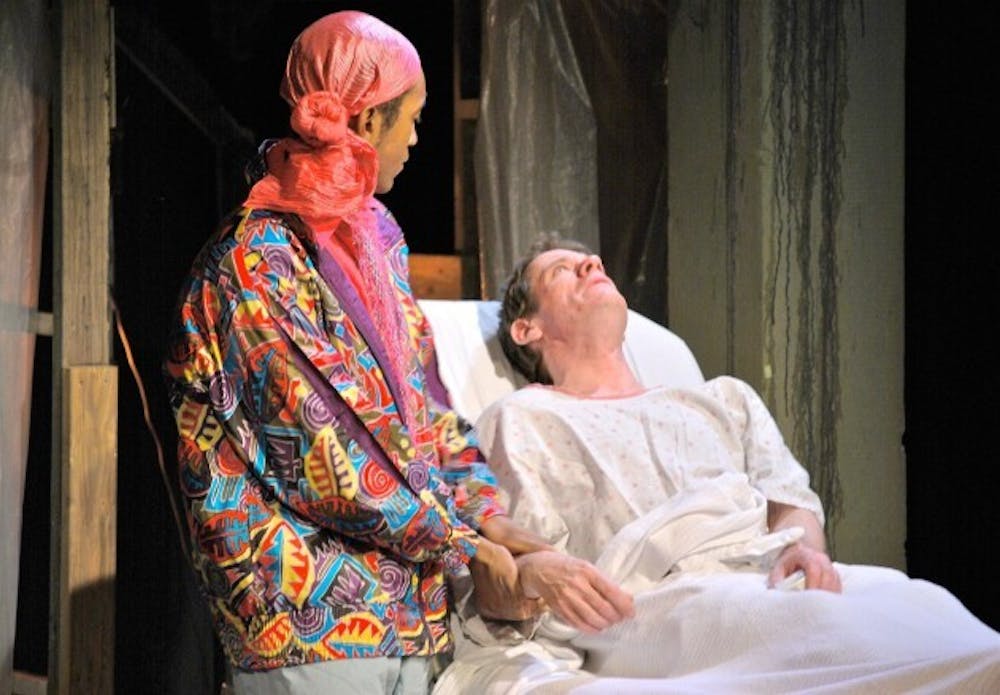A huge theater, elaborate costumes and over 20 stage crewmembers aren't necessary to put on an extraordinary theatrical performance - an exemplary set is. Tony Kushner's Angels in America proves that with its flawless acting conjoined with its multi-faceted stage.
Angels in America Part I: Millennium Approaches,a Subversive Theatre production, is currently playing at the Manny Fried Playhouse. The play depicts the lives of several people who are struggling to accept themselves and the world around them in a time of political uncertainty and sexual ambiguity.
The play opened with a rabbi standing over a woman's grave as he informed the audience they are gathered at a funeral in New York City - a city he refers to as, "a melting pot where no one melted." The rabbi, played by Timothy Patrick Finnegan, immediately sets the tone for this wonderfully executed play. The rabbi is Finnegan's first character to appear onstage, as he portrays four characters in total.
Brian Riggs' portrayal of Prior Walter truly depicts the pain and suffering men and women went through during the '80s in New York City. Riggs' ability to capture Walter's struggle with AIDS and abandonment helped to draw the audience closer into his world.
Kristin Bentley, a 27-year-old UB alumnus, played Harper Pitt, a character plagued by mental illness.
"I really love Harper and her quirky ways," Bentley said. "I think the women in the audience can connect with her and how she is trying to hold on to a relationship. I can feel the women in the crowd respond to that, and it really propels me as an actress."
While the actors did a good job of bringing the audience into their characters' lives, the brilliant stage design made audience members feel like they were in several different worlds at once. The set pieces are covered in white fabric and the set is built with plastic sheets used as walls and screens for projections. The projections included videos of cells moving across the stage, giving the set a gorgeous layer of organic texture.
"The images on the projection were supposed to create living organisms; there is always something living and breathing on the stage," said Christopher Standart, the director of Millennium Approaches.
Even the colors of the lights were significant to the play's theme. The red emblematizes not only the blood of those succumbed to the symptoms of AIDS but also simply the fiery emotions this play can evoke.
"It's a challenge to create this on stage," said Katie Little, 22. "But they approached the play in a way that was believable."
Angels in America may mean something different to each person in the audience and each viewer considers the play meaningful in his or her own way.
Actor and adjunct Buffalo State College professor Tim Joyce played eccentric New York lawyer Roy Cohn, a big-time lawyer who is also diagnosed with AIDS. Standart approached Joyce about taking on the role of Cohn after working together on Richard III last summer at Shakespeare in the Park. Joyce was ecstatic but explained he had reservations about stepping into such a huge role.
"I've acted in over 100 plays and this is one of three best parts I've ever gotten," Joyce said. "I was excited, but nervous I wouldn't live up to the role ... It's like when you're cast as Hamlet - you better nail it."
Angels in America: Part I: Millennium Approachesandits second part - Perestroika, directed by Christian Brandjes - will run at the Manny Fried Playhouse until Feb. 16.
Email: arts@ubspectrum.com





